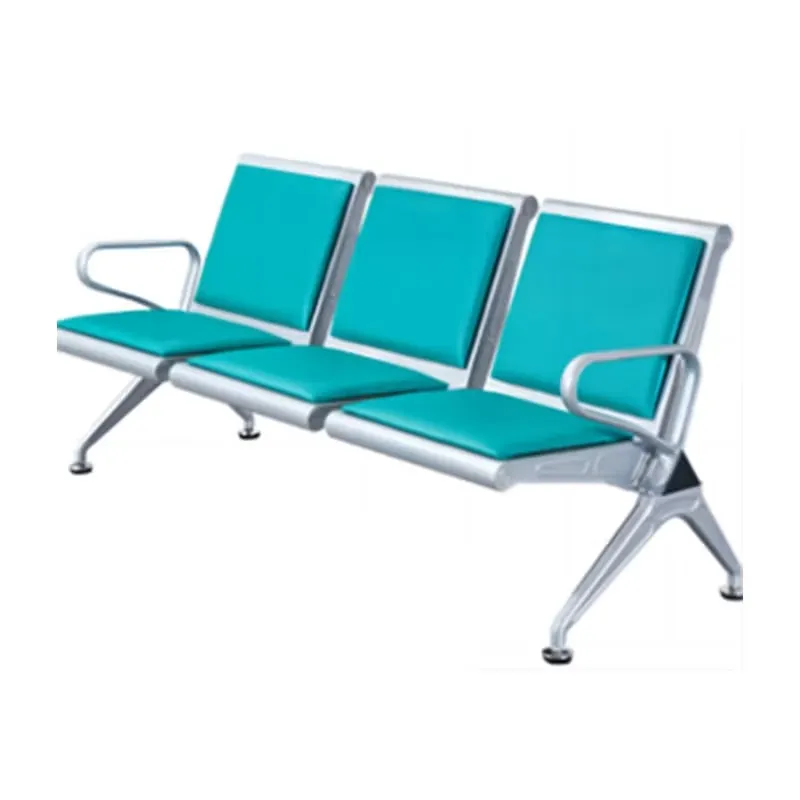Hospital Waiting Area Chairs – Safe, Durable & Easy-Clean
What I Look For In Hospital Waiting Area Chairs (And What Facilities Are Quietly Switching To)
After a decade of walking hospital corridors and talking with facilities teams, I’ve developed a minor obsession with hospital waiting area chairs. Sounds niche, I know—but when they’re wrong, everybody complains. When they’re right, nobody notices (which is the point). Recently I visited a site in Hebei Province, China—Zhouhu Village, Jizhou Zone, Hengshui City—where a practical, no-nonsense bench line caught my eye: Wholesale Factory PU Cushion Padding Aluminum Hospital Linkage Row Waiting Chair. The name’s a mouthful; the build is all business.

Industry Trends I’m Seeing
-
- Infection control first: sealed seams, non-porous finishes, and easy wipe-down surfaces.
- Durability over aesthetics (but not ignoring aesthetics): powder coats in calm, matte tones; anti-rust steel frames.
- Modular “linkage” rows that reconfigure as departments expand or merge.
- Quiet ergonomics: subtle lumbar and seat perforations for breathability, fewer squeaks/rattles.
- Certifications creep: EN 16139, ANSI/BIFMA X5.4, and BS 5852 show up more in spec sheets.
How This Chair Is Built (Short Version)
Seat and back are formed from top-quality cold-rolled steel (perforated), then anti-rust treated, electronically polished, and static coated. Thickness ≈1.5 mm, width 50. Arms/legs: die-cast/deep-drawn steel at ≈1.5 mm. Beam and bracket: 2.0 mm steel with cutting–perforating–welding–anti-rust–static coating sequence. In plain English: a rigid spine with a serviceable skin. It’s the reliable Toyota of hospital waiting area chairs, if you will.

Product Specifications (Typical Configuration)
| Model | Linkage Row (2–5 seats) |
| Seat/Back | Perforated cold-rolled steel, ≈1.5 mm, anti-rust + electronic polish + static coating |
| Arms/Legs | Die-cast/deep-drawn steel, ≈1.5 mm; polished finish |
| Beam/Bracket | High-strength steel, ≈2.0 mm, welded; static powder coat |
| Cushion | PU padding option; wipe-clean surface |
| Load Rating | ≈150–200 kg per seat (lab tested; real-world use may vary) |
| Finish | Anti-rust pretreatment + powder coat (custom colors) |
| Service Life | ≈8–10 years with routine maintenance |
Process Flow, Testing, and Standards
Materials enter cutting and perforation, then welding and stress relief, anti-rust treatment, electronic polishing, and static powder coating. Random samples undergo salt-spray (ASTM B117, often 72–120 hrs), seat/back fatigue (EN 16139/ANSI-BIFMA X5.4), stability per ISO 7173, and foam/fire checks referencing BS 5852/CAL 117 where specified. In infection-prone zones, facilities teams ask for smooth radii, sealed PU cushions, and bleach-safe finishes—frankly, a must now.

Where It Fits (and Why Users Don’t Hate It)
-
- Outpatient and imaging corridors: fast turnover, easy wipe-downs.
- Emergency triage spillover: sturdy beam keeps alignment under load.
- Pharmacy queues: modular rows reduce floor clutter and “seat creep.”
- Caregiver lounges: PU pads earn quiet thanks during long waits.
Feedback I hear: “Solid, no wobble,” “surprisingly comfy for metal,” and “cleaning team likes the finish.” That last one is gold.
Vendor Snapshot: Who Does What
| Vendor | Frame & Finish | Certs (typ.) | Lead Time | Customization |
| Zhaofa (Hebei) | 1.5/2.0 mm steel; anti-rust + powder coat | EN 16139, BIFMA X5.4 (on request) | ≈20–30 days | Seat count, colors, PU pad, arm/leg style |
| Vendor A | Aluminum beam; powder coat | EN 16139; BS 5852 foams | ≈25–35 days | Upholstery, arm caps |
| Vendor B | Steel beam; chrome or powder | BIFMA X5.4 | ≈30–40 days | Widths, arm position |
Customization & Real-World Case
Options usually include 2–5 seat rows, mixed arms (end-only vs. every seat), PU padding, and powder-coat colors to match department palettes. One regional hospital replaced a motley fleet of single seats with 4-seat rows of hospital waiting area chairs in triage. Result: cleaner lines, 18% more seating density, faster nightly cleaning (fewer legs to mop around). Not glamorous, but the nurses noticed.

Why Choose This Build
-
- Sturdy beam architecture; fewer moving parts to fail.
- Perforated steel improves thermal comfort vs. solid pans.
- Anti-rust + powder coat tolerates hospital-grade cleaners.
- Linkage layout keeps egress clear—safety teams appreciate that.
Bottom line: for facilities needing dependable hospital waiting area chairs with minimal fuss, this Hebei-made row chair checks the boxes—especially when you need scale, spare parts, and repeatable finishes.
Authoritative References
- EN 16139: Furniture—Strength, durability and safety—Requirements for non-domestic seating. https://standards.iteh.ai/catalog/standards/cen/5eaa5c3e-1a4c-4d7e-8d0d-6a6f1f6f1a78/en-16139-2013
- ANSI/BIFMA X5.4: Lounge and Public Seating. https://www.bifma.org/page/standards
- BS 5852: Fire tests for seating. https://knowledge.bsigroup.com/products/fire-test-methods-for-seating
- ASTM B117: Standard Practice for Operating Salt Spray Apparatus. https://www.astm.org/b0117-19.html
- FGI Guidelines for Design and Construction of Hospitals. https://fgiguidelines.org/guidelines/




































